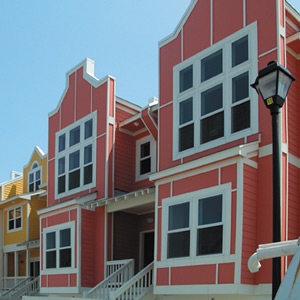Mechanically assembled for reliability
Since fiberglass windows and doors are often mechanically-assembled in the factory through chemically-welded or bonded assemblies, they provide a high degree of quality, consistency and reliability.
Fiberglass CAN take the heat!
Know how it feels to wear dark-colored clothing on a hot summer day? You can literally feel the heat as the sun’s rays beat down over time. Dark colors absorb heat, and prolonged heat buildup can cause exterior building products to change over time, especially in climates where sizzling temperatures prevail. That distortion can lead to water penetration or air infiltration, wasting energy and reducing the potential lifespan or performance of your windows and doors. That’s why it’s important to choose building materials that are designed to withstand the challenges of your unique climate conditions.
Tough enough to take on hurricanes
Fiberglass fenestration products are known for their durability. That’s why they’re a natural choice for coastal applications where hurricane-force winds can occur. When combined with impact-resistant glass that is designed to prevent debris and flying objects from penetrating the glass to enter the home or business, fiberglass windows and doors help protect the building and its occupants year-round.
Colorful options, durable solutions
Fiberglass windows and doors have the ability to take on dark colors without warping under the searing elements of rugged climates like those from Arizona to Alaska. Fiberglass withstands heat deflection temperatures of 250 degrees or more, to reduce the potential for warping, especially when used in dark colors or southern exposures. In fact, fiberglass can withstand frigid winters and allow users to install fiberglass building products even in the extreme cold conditions like those of winters in the Dakotas or across Canada.
From light to dark and many shades in between, you’ll find a wide array of colors available in today’s fiberglass fenestration materials. Energy efficiency is maintained even with dark colored coatings, as fiberglass’ low thermal conductivity blocks the heat. That means you can have it all: dark-colored fiberglass building materials that are truly energy-efficient. Many fiberglass windows and doors are also available with different color options on the interior and exterior for added design flexibility.
See the light
The slim sightlines of fiberglass fenestration materials provide more visible glass area to enhance desired solar heat gain. This means that you enjoy more of the view from your home or commercial setting when you choose fiberglass products because there is less obstruction blocking your view. That’s why fiberglass fenestration materials are a natural option to enhance daylighting, thanks to their ability to maximize the visible glass area.
Able to take on different looks
Fiberglass can take on the natural look of simulated grains or a smooth appearance to provide a sleek, contemporary look that can be painted or stained.
Because of its versatility, fiberglass combines with other materials traditionally used in building materials. For example, fiberglass sills are often found in wood doors, and fiberglass-clad sashes and frames can be featured in windows together with other materials like those products with wood interiors.




